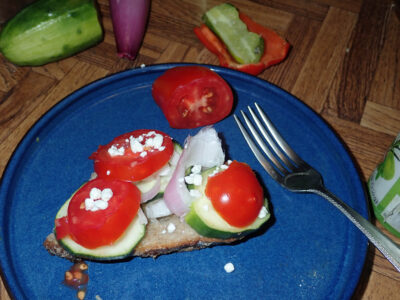Summer is Time for Peas!

“There is nothing so innocent, so confiding in its expression, as the small green face of the freshly shelled spring pea.” — William Wallace Irwin in the Garrulous Gourmet.
It’s summer. Fourth of July fireworks are behind us. Gardens and farmstands are full of sweet summer peas.
Fresh peas have a limited season and are a rarity at the supermarket. By the time they reach the store shelf, they have lost most of their sweetness. At room temperature, half their sugar content will turn into starch in a few hours and they will become mealy. Refrigeration slows, but does not stop this process. Therefore, 95% of commercially grown peas are canned, frozen or dried into split peas.
These early summer delicacies come in three main varieties: shelling peas, Oriental pod peas and sugar snap peas. All peas can be cooked quickly or eaten raw.
Peas are an ancient food that probably originated in Burma and Thailand, where they were first gathered wild. Later, they were cultivated in China. They spread west to Mesopotamia (modern Iraq) and then to southern Europe. The Roman author Apicius had several pea recipes in his cookbook.
Shelled, dried peas have been a favorite British dish for centuries. Abundant, inexpensive and wholesome, they were stored for winter use and became a common staple and part of European folklore. One example is The Princess and the Pea by Hans Christian Andersen; others are found in English nursery rhymes. Traditional English dishes made with dried peas are Pease Pudding, Green Pea Cakes and Scottish Brose.
Fresh green peas did not come on the market until the 14th century in Italy and the 15th century in France; they were known as Piselli novella in Italy and petit pois in France. By the 16th century, green peas were common throughout Europe. Because they were so popular, peas were one of the first vegetables to be commercially canned by Campbell’s in 1870. Canned peas, however, lose much of their flavor, and their bright green color turns a dull brown.
Pod peas have been cultivated in Thailand and Burma for thousands of years. Today they are a common ingredient in Oriental dishes like stir-fries and fried rice, where they provide vibrant color, sweetness and crunch. They can be eaten raw, but a quick blanching of 30 to 60 seconds brings out their vivid green and heightens their crispness.
Sugar snap peas are a modern hybrid, developed by Dr. Calvin Lamborn and Dr. M. C. Parker for the Gallatin Valley Seed Co. in Idaho in the late 1960s. This cross between English shell peas and Oriental snow peas has a higher yield than the English pea and is sweeter and fatter than the Asian snow pea. Whereas Oriental snow peas are thin, empty pods, snap peas are full, with both peas and pods.
Because peas are legumes, they’re a good source of protein, fiber and carbohydrates and are low in fat. They contain many B complex vitamins, including folic acid, as well as vitamin A and the minerals calcium, iron, zinc, potassium and magnesium. A half-cup serving of fresh-shelled peas contains 62 calories, 4 grams of protein, 11 grams of carbohydrates and 4 grams of fiber.
Because the pods are mostly water, pod peas are lower in carbohydrates and fats than round-shell peas. Filling and nutritious, they’re a good source of vitamins A, C, thiamin, riboflavin and niacin, as well as impressive amounts of phosphorus, iron and potassium. Just 1 cup provides one-third of your Daily Value of vitamin C and 3 grams of fiber.
When buying shelling peas at the farmer’s market, look for pods that are full, shiny, crisp and green, with a velvety feel. Move them around; the peas should rattle a bit in the pod. Avoid pods that are very large, puffy, dulled, yellowed or dry. You will need a lot; a pound of pod peas will yield only about a cup when shelled. But don’t buy too much at once; it’s best to eat them the day you buy them. Keep them refrigerated and in the pods until you plan to use them.
To use, rinse the pods, then pinch off the top and pull the string to open. You can push out peas clinging to the pod with your finger. They can be eaten raw, steamed or cooked in the microwave. They cook quickly; three to five minutes should be enough. A classic French method is to steam them in a nest of lettuce leaves, Avoid using salt in the cooking process, as it toughens the peas. If you want to season them, do so after they’re cooked, with a little butter and salt, sugar or fresh herbs.
When buying sugar snaps or Asian pod peas, look for firm, crisp, bright green pods with no signs of yellowing, browning or decay; avoid any that are dry or shriveled. As with corn, the sugar begins to turn to starch soon after harvest, so the fresher, the sweeter. Use as soon as possible after purchase.
To prepare, rinse and remove the strings that run along the edges of the pod from base to tip. Cut off the tips, pull along both sides of the pod to remove the strings and discard them.
Serve raw, whole snap peas with a creamy dip or hummus as an appetizer or cut into a salad. Stir-fry them whole with meat and other vegetables, and serve with soy sauce and rice. When braising meat and vegetables, add snap peas during the last 5 minutes of cooking.
Shelled peas need to be shelled and the shells discarded into the compost or cooked down for a sweet vegetable broth. To prepare pod peas, cut off the end and pull sharply down the entire length of the pod to remove the strings. Steam or stir-fry for just 1 or 2 minutes to preserve their flavor and crunch. Combine with young onions, mushrooms and water chestnuts.
–
New Potatoes and Peas Skillet
–
This dish is good with shell peas, sugar snaps or snow peas. You choose!
–
Ingredients:
–
1 to 2 Tablespoons butter
2 cups potatoes
1/2 teaspoon salt
1 onion
2 or 3 cups peas
2 Tablespoons fresh minced parsley
2 Tablespoons fresh minced chives
–
Directions:
–
Shell peas, or remove strings. Set aside.
In a large skillet, melt some of the butter. Beat eggs with a little water and/or milk until frothy. Pour into skillet, tip skillet to spread evenly and cook until set (or turn over). Remove to a plate and set aside.
In the same skillet, melt the remaining butter. Peel (optional) and slice potatoes thinly, add to skillet, sprinkle with salt, cover and cook on low heat for about 5 minutes. Peel and dice the onion, stir into the potatoes and cook 5 more minutes or until the potatoes are almost tender. Add peas, herbs and eggs to the skillet, and cook, stirring, another 2 to 4 minutes. Serve hot with a green salad for a light supper or lunch.
Option: For additional protein, add 1 or 2 cups of diced ham or cooked chicken when adding the peas.
Serves three to four.
–
Oriental Style Grain and Peas
–
Ingredients:
–
1 cup rice, millet, barley or quinoa
2 cups water or broth
1 Tablespoon soy sauce
1 teaspoon honey
1 cup shelled peas
1 dozen snap peas or pod peas
1 cup chives
1 small carrot, grated
1 Tablespoon fresh mint
1/4 teaspoon ground ginger
Diced cooked chicken (optional)
–
Directions:
–
Cook your grain with broth or water, soy sauce and honey until grain is tender and liquid is absorbed. Stir peas into hot grain, cover and turn off the heat. Slice the chives, grate the carrot, chop the fresh mint and add. Stir in ginger and diced cooked chicken, if using. Grain and peas combine to make a complete protein.
Serves three to four.
–
Oriental peas with eggs
–
Ingredients:
–
1-quart snow peas
1 Tablespoon butter or olive oil
1 large onion
6 ounces sliced mushrooms
1 teaspoon butter
4 eggs
1 to 2 Tablespoons soy sauce
–
Directions:
–
String and rinse the peas. Set aside.
Heat butter in a large skillet. Peel and dice the onion; add, along with optional mushrooms and cook on low, covered for 10 to 15 minutes.
While the onions are cooking, beat the eggs. Heat more butter in a second large skillet and pour in the eggs to make a thin omelet. Cook until settled, and set aside to cool slightly.
Add prepared snow peas to the onions and mushrooms, raise the heat and cook, stirring, about 1 minute. Cut egg into strips, and stir in. Season with soy sauce and serve over rice, or with potatoes or noodles or with a good crusty bread.
Option: Cook a chicken breast instead of the eggs, and add to the skillet or use leftover cooked chicken, chopped or shredded.
Serves three.
— — —
Author of the award-winning cookbook Garden Gourmet: Fresh & Fabulous Meals from your Garden, CSA or Farmers’ Market, Yvona Fast lives in Lake Clear and has two passions: writing and cooking. She can be found at www.yvonafast.com and reached at yvonawrite@yahoo.com or on Twitter: @yvonawrites.





